Improving Nursing Teamwork Through Interventions
VerifiedAdded on 2020/04/07
|10
|3552
|304
AI Summary
This assignment examines various interventions aimed at improving nursing teamwork in healthcare settings. It delves into studies utilizing virtual simulations, train-the-trainer programs, and mindfulness groups to assess their effectiveness in fostering collaboration and reducing missed care. The analysis considers the impact of organizational culture and team dynamics on intervention success.
Contribute Materials
Your contribution can guide someone’s learning journey. Share your
documents today.
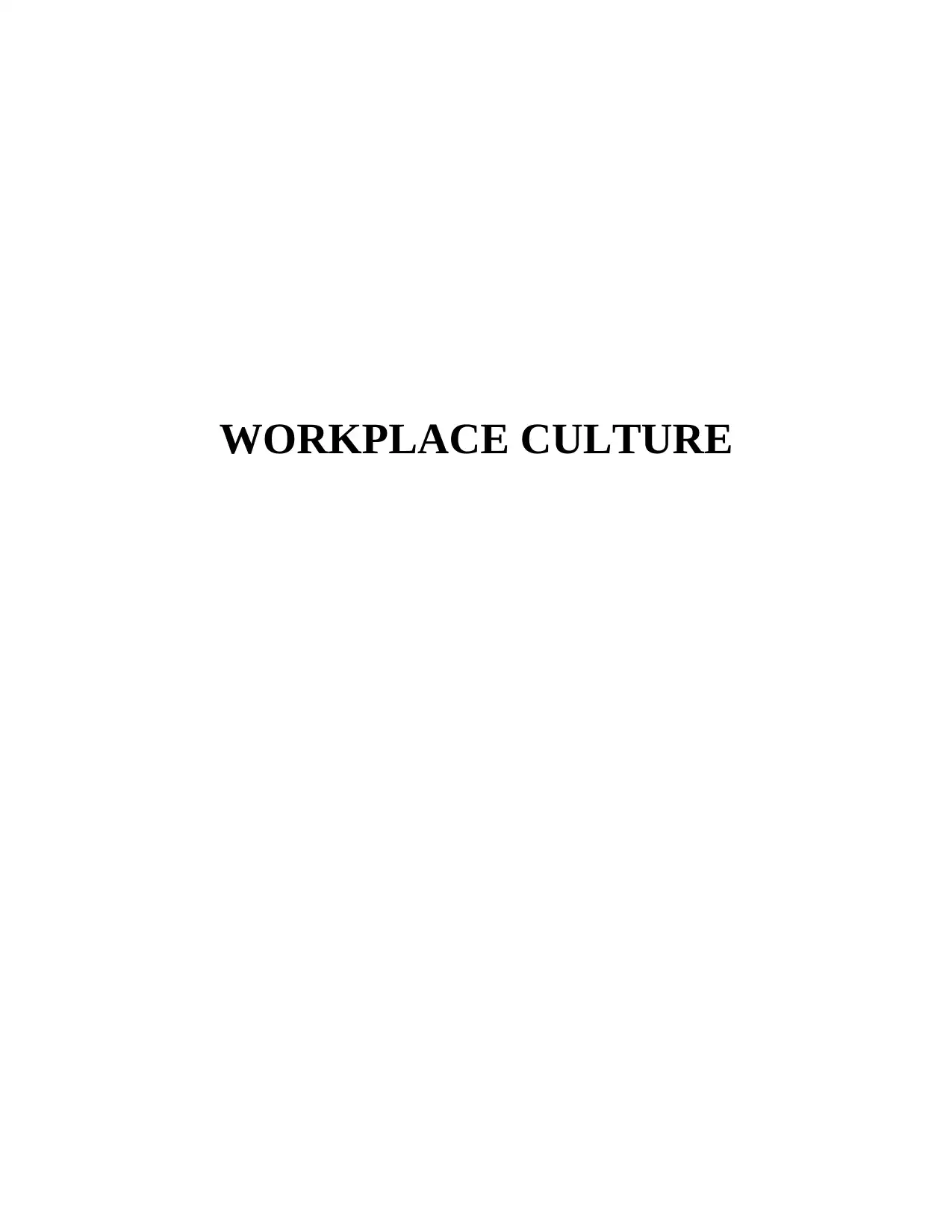
WORKPLACE CULTURE
Secure Best Marks with AI Grader
Need help grading? Try our AI Grader for instant feedback on your assignments.
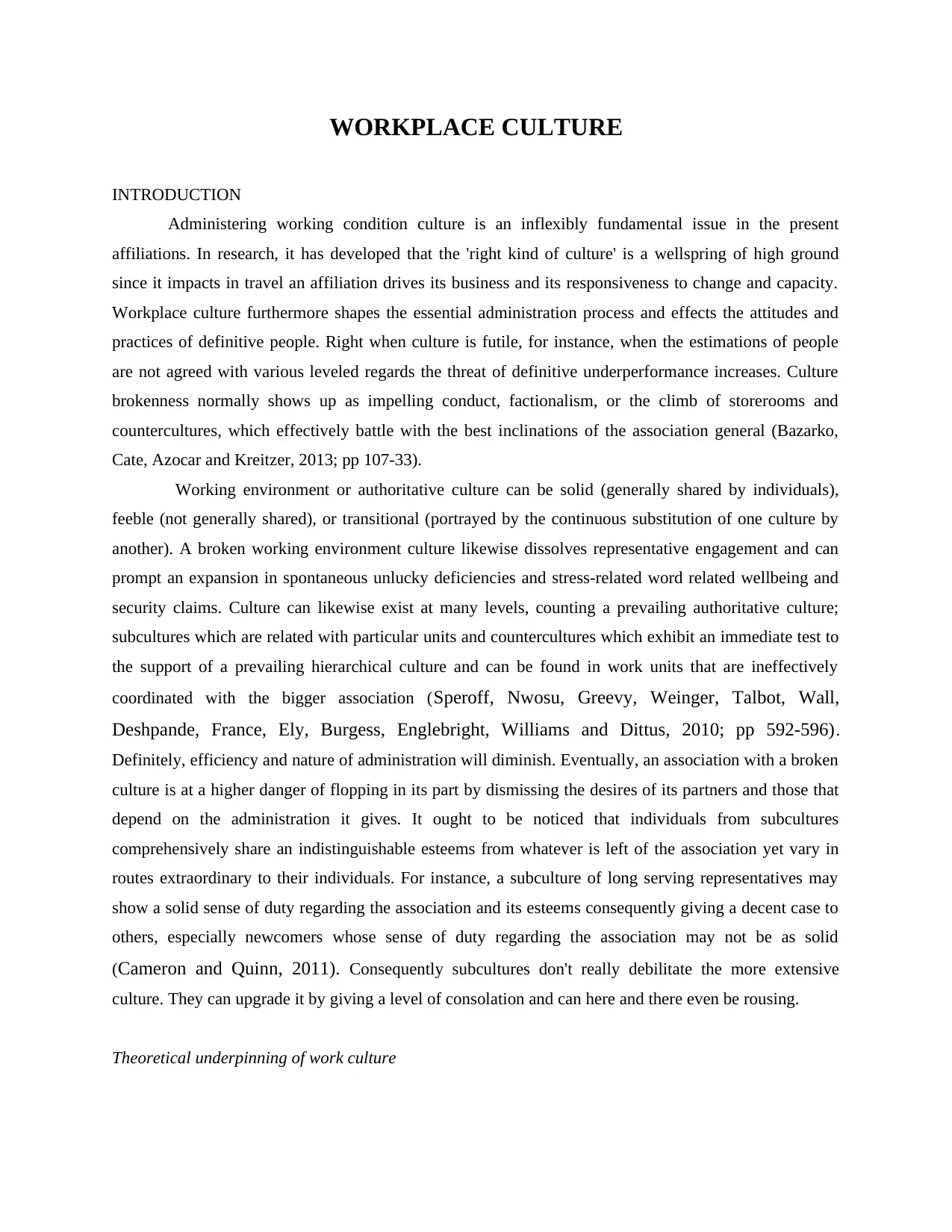
WORKPLACE CULTURE
INTRODUCTION
Administering working condition culture is an inflexibly fundamental issue in the present
affiliations. In research, it has developed that the 'right kind of culture' is a wellspring of high ground
since it impacts in travel an affiliation drives its business and its responsiveness to change and capacity.
Workplace culture furthermore shapes the essential administration process and effects the attitudes and
practices of definitive people. Right when culture is futile, for instance, when the estimations of people
are not agreed with various leveled regards the threat of definitive underperformance increases. Culture
brokenness normally shows up as impelling conduct, factionalism, or the climb of storerooms and
countercultures, which effectively battle with the best inclinations of the association general (Bazarko,
Cate, Azocar and Kreitzer, 2013; pp 107-33).
Working environment or authoritative culture can be solid (generally shared by individuals),
feeble (not generally shared), or transitional (portrayed by the continuous substitution of one culture by
another). A broken working environment culture likewise dissolves representative engagement and can
prompt an expansion in spontaneous unlucky deficiencies and stress-related word related wellbeing and
security claims. Culture can likewise exist at many levels, counting a prevailing authoritative culture;
subcultures which are related with particular units and countercultures which exhibit an immediate test to
the support of a prevailing hierarchical culture and can be found in work units that are ineffectively
coordinated with the bigger association (Speroff, Nwosu, Greevy, Weinger, Talbot, Wall,
Deshpande, France, Ely, Burgess, Englebright, Williams and Dittus, 2010; pp 592-596).
Definitely, efficiency and nature of administration will diminish. Eventually, an association with a broken
culture is at a higher danger of flopping in its part by dismissing the desires of its partners and those that
depend on the administration it gives. It ought to be noticed that individuals from subcultures
comprehensively share an indistinguishable esteems from whatever is left of the association yet vary in
routes extraordinary to their individuals. For instance, a subculture of long serving representatives may
show a solid sense of duty regarding the association and its esteems consequently giving a decent case to
others, especially newcomers whose sense of duty regarding the association may not be as solid
(Cameron and Quinn, 2011). Consequently subcultures don't really debilitate the more extensive
culture. They can upgrade it by giving a level of consolation and can here and there even be rousing.
Theoretical underpinning of work culture
INTRODUCTION
Administering working condition culture is an inflexibly fundamental issue in the present
affiliations. In research, it has developed that the 'right kind of culture' is a wellspring of high ground
since it impacts in travel an affiliation drives its business and its responsiveness to change and capacity.
Workplace culture furthermore shapes the essential administration process and effects the attitudes and
practices of definitive people. Right when culture is futile, for instance, when the estimations of people
are not agreed with various leveled regards the threat of definitive underperformance increases. Culture
brokenness normally shows up as impelling conduct, factionalism, or the climb of storerooms and
countercultures, which effectively battle with the best inclinations of the association general (Bazarko,
Cate, Azocar and Kreitzer, 2013; pp 107-33).
Working environment or authoritative culture can be solid (generally shared by individuals),
feeble (not generally shared), or transitional (portrayed by the continuous substitution of one culture by
another). A broken working environment culture likewise dissolves representative engagement and can
prompt an expansion in spontaneous unlucky deficiencies and stress-related word related wellbeing and
security claims. Culture can likewise exist at many levels, counting a prevailing authoritative culture;
subcultures which are related with particular units and countercultures which exhibit an immediate test to
the support of a prevailing hierarchical culture and can be found in work units that are ineffectively
coordinated with the bigger association (Speroff, Nwosu, Greevy, Weinger, Talbot, Wall,
Deshpande, France, Ely, Burgess, Englebright, Williams and Dittus, 2010; pp 592-596).
Definitely, efficiency and nature of administration will diminish. Eventually, an association with a broken
culture is at a higher danger of flopping in its part by dismissing the desires of its partners and those that
depend on the administration it gives. It ought to be noticed that individuals from subcultures
comprehensively share an indistinguishable esteems from whatever is left of the association yet vary in
routes extraordinary to their individuals. For instance, a subculture of long serving representatives may
show a solid sense of duty regarding the association and its esteems consequently giving a decent case to
others, especially newcomers whose sense of duty regarding the association may not be as solid
(Cameron and Quinn, 2011). Consequently subcultures don't really debilitate the more extensive
culture. They can upgrade it by giving a level of consolation and can here and there even be rousing.
Theoretical underpinning of work culture
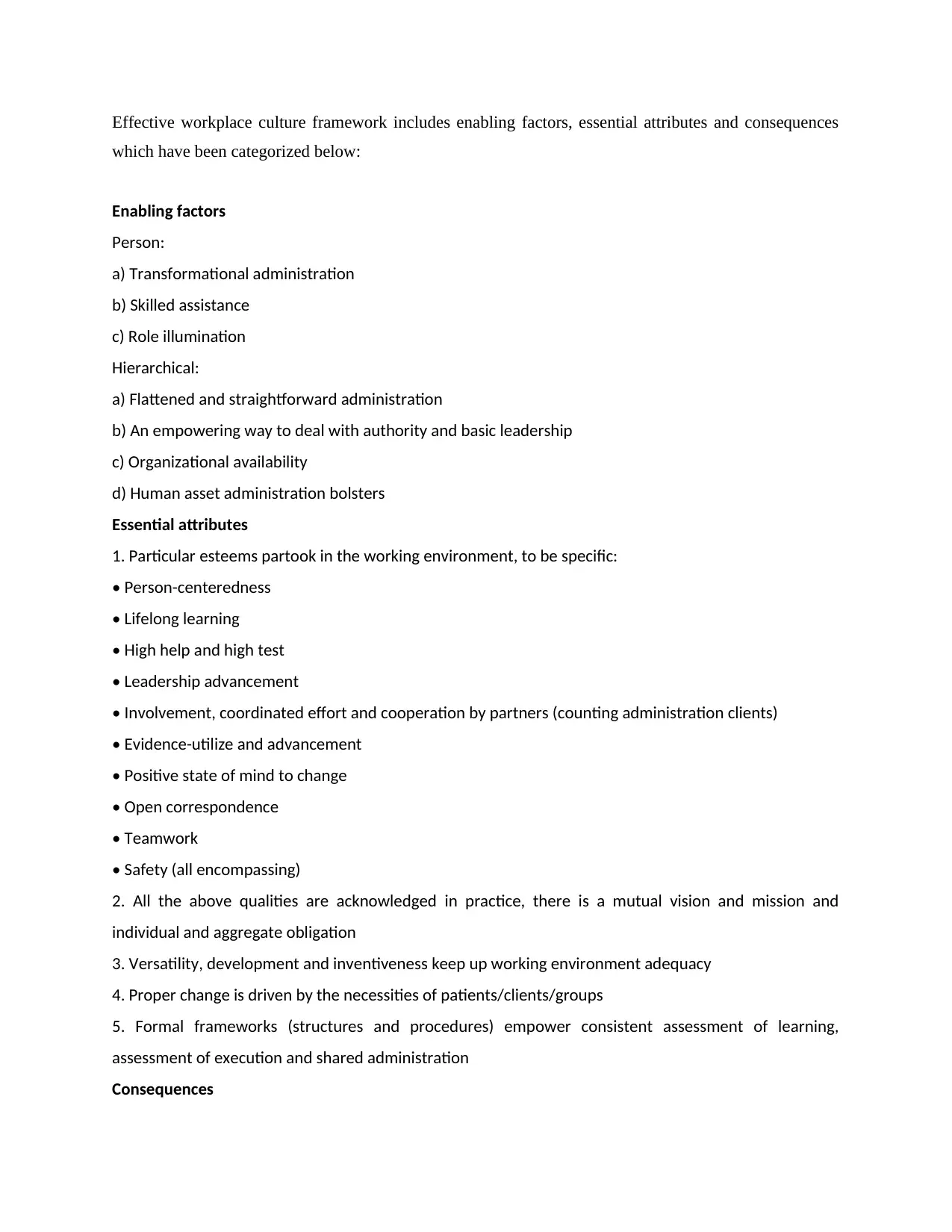
Effective workplace culture framework includes enabling factors, essential attributes and consequences
which have been categorized below:
Enabling factors
Person:
a) Transformational administration
b) Skilled assistance
c) Role illumination
Hierarchical:
a) Flattened and straightforward administration
b) An empowering way to deal with authority and basic leadership
c) Organizational availability
d) Human asset administration bolsters
Essential attributes
1. Particular esteems partook in the working environment, to be specific:
• Person-centeredness
• Lifelong learning
• High help and high test
• Leadership advancement
• Involvement, coordinated effort and cooperation by partners (counting administration clients)
• Evidence-utilize and advancement
• Positive state of mind to change
• Open correspondence
• Teamwork
• Safety (all encompassing)
2. All the above qualities are acknowledged in practice, there is a mutual vision and mission and
individual and aggregate obligation
3. Versatility, development and inventiveness keep up working environment adequacy
4. Proper change is driven by the necessities of patients/clients/groups
5. Formal frameworks (structures and procedures) empower consistent assessment of learning,
assessment of execution and shared administration
Consequences
which have been categorized below:
Enabling factors
Person:
a) Transformational administration
b) Skilled assistance
c) Role illumination
Hierarchical:
a) Flattened and straightforward administration
b) An empowering way to deal with authority and basic leadership
c) Organizational availability
d) Human asset administration bolsters
Essential attributes
1. Particular esteems partook in the working environment, to be specific:
• Person-centeredness
• Lifelong learning
• High help and high test
• Leadership advancement
• Involvement, coordinated effort and cooperation by partners (counting administration clients)
• Evidence-utilize and advancement
• Positive state of mind to change
• Open correspondence
• Teamwork
• Safety (all encompassing)
2. All the above qualities are acknowledged in practice, there is a mutual vision and mission and
individual and aggregate obligation
3. Versatility, development and inventiveness keep up working environment adequacy
4. Proper change is driven by the necessities of patients/clients/groups
5. Formal frameworks (structures and procedures) empower consistent assessment of learning,
assessment of execution and shared administration
Consequences
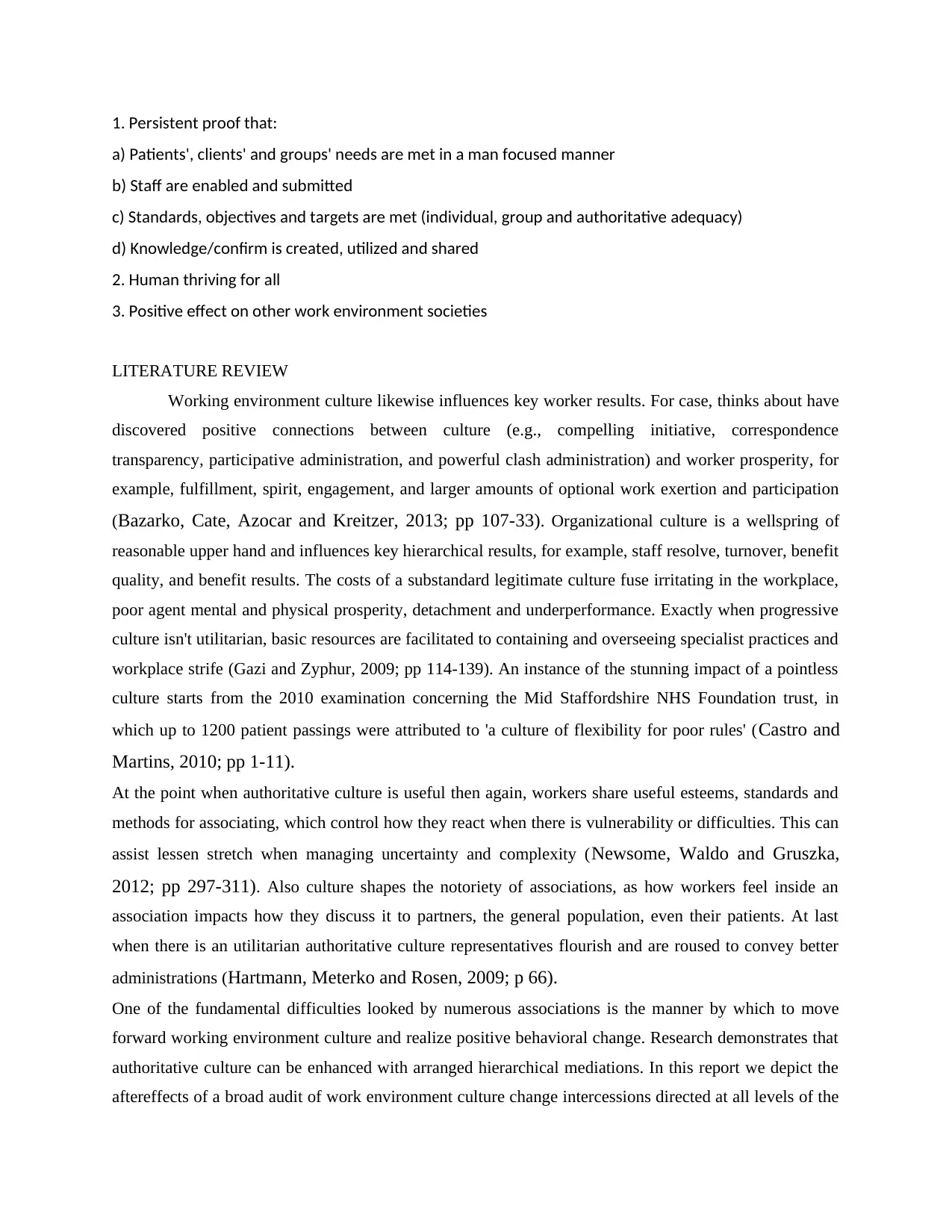
1. Persistent proof that:
a) Patients', clients' and groups' needs are met in a man focused manner
b) Staff are enabled and submitted
c) Standards, objectives and targets are met (individual, group and authoritative adequacy)
d) Knowledge/confirm is created, utilized and shared
2. Human thriving for all
3. Positive effect on other work environment societies
LITERATURE REVIEW
Working environment culture likewise influences key worker results. For case, thinks about have
discovered positive connections between culture (e.g., compelling initiative, correspondence
transparency, participative administration, and powerful clash administration) and worker prosperity, for
example, fulfillment, spirit, engagement, and larger amounts of optional work exertion and participation
(Bazarko, Cate, Azocar and Kreitzer, 2013; pp 107-33). Organizational culture is a wellspring of
reasonable upper hand and influences key hierarchical results, for example, staff resolve, turnover, benefit
quality, and benefit results. The costs of a substandard legitimate culture fuse irritating in the workplace,
poor agent mental and physical prosperity, detachment and underperformance. Exactly when progressive
culture isn't utilitarian, basic resources are facilitated to containing and overseeing specialist practices and
workplace strife (Gazi and Zyphur, 2009; pp 114-139). An instance of the stunning impact of a pointless
culture starts from the 2010 examination concerning the Mid Staffordshire NHS Foundation trust, in
which up to 1200 patient passings were attributed to 'a culture of flexibility for poor rules' (Castro and
Martins, 2010; pp 1-11).
At the point when authoritative culture is useful then again, workers share useful esteems, standards and
methods for associating, which control how they react when there is vulnerability or difficulties. This can
assist lessen stretch when managing uncertainty and complexity (Newsome, Waldo and Gruszka,
2012; pp 297-311). Also culture shapes the notoriety of associations, as how workers feel inside an
association impacts how they discuss it to partners, the general population, even their patients. At last
when there is an utilitarian authoritative culture representatives flourish and are roused to convey better
administrations (Hartmann, Meterko and Rosen, 2009; p 66).
One of the fundamental difficulties looked by numerous associations is the manner by which to move
forward working environment culture and realize positive behavioral change. Research demonstrates that
authoritative culture can be enhanced with arranged hierarchical mediations. In this report we depict the
aftereffects of a broad audit of work environment culture change intercessions directed at all levels of the
a) Patients', clients' and groups' needs are met in a man focused manner
b) Staff are enabled and submitted
c) Standards, objectives and targets are met (individual, group and authoritative adequacy)
d) Knowledge/confirm is created, utilized and shared
2. Human thriving for all
3. Positive effect on other work environment societies
LITERATURE REVIEW
Working environment culture likewise influences key worker results. For case, thinks about have
discovered positive connections between culture (e.g., compelling initiative, correspondence
transparency, participative administration, and powerful clash administration) and worker prosperity, for
example, fulfillment, spirit, engagement, and larger amounts of optional work exertion and participation
(Bazarko, Cate, Azocar and Kreitzer, 2013; pp 107-33). Organizational culture is a wellspring of
reasonable upper hand and influences key hierarchical results, for example, staff resolve, turnover, benefit
quality, and benefit results. The costs of a substandard legitimate culture fuse irritating in the workplace,
poor agent mental and physical prosperity, detachment and underperformance. Exactly when progressive
culture isn't utilitarian, basic resources are facilitated to containing and overseeing specialist practices and
workplace strife (Gazi and Zyphur, 2009; pp 114-139). An instance of the stunning impact of a pointless
culture starts from the 2010 examination concerning the Mid Staffordshire NHS Foundation trust, in
which up to 1200 patient passings were attributed to 'a culture of flexibility for poor rules' (Castro and
Martins, 2010; pp 1-11).
At the point when authoritative culture is useful then again, workers share useful esteems, standards and
methods for associating, which control how they react when there is vulnerability or difficulties. This can
assist lessen stretch when managing uncertainty and complexity (Newsome, Waldo and Gruszka,
2012; pp 297-311). Also culture shapes the notoriety of associations, as how workers feel inside an
association impacts how they discuss it to partners, the general population, even their patients. At last
when there is an utilitarian authoritative culture representatives flourish and are roused to convey better
administrations (Hartmann, Meterko and Rosen, 2009; p 66).
One of the fundamental difficulties looked by numerous associations is the manner by which to move
forward working environment culture and realize positive behavioral change. Research demonstrates that
authoritative culture can be enhanced with arranged hierarchical mediations. In this report we depict the
aftereffects of a broad audit of work environment culture change intercessions directed at all levels of the
Secure Best Marks with AI Grader
Need help grading? Try our AI Grader for instant feedback on your assignments.
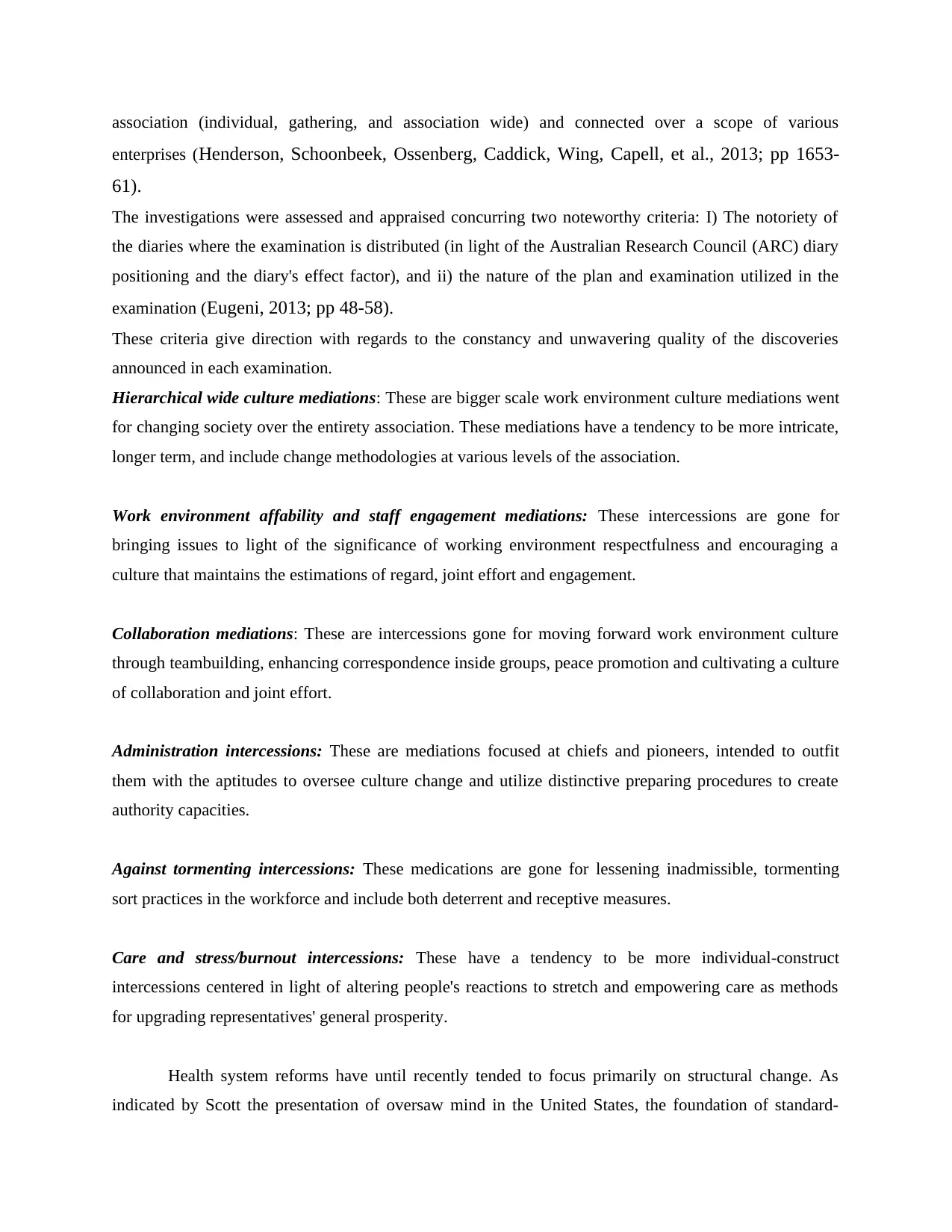
association (individual, gathering, and association wide) and connected over a scope of various
enterprises (Henderson, Schoonbeek, Ossenberg, Caddick, Wing, Capell, et al., 2013; pp 1653-
61).
The investigations were assessed and appraised concurring two noteworthy criteria: I) The notoriety of
the diaries where the examination is distributed (in light of the Australian Research Council (ARC) diary
positioning and the diary's effect factor), and ii) the nature of the plan and examination utilized in the
examination (Eugeni, 2013; pp 48-58).
These criteria give direction with regards to the constancy and unwavering quality of the discoveries
announced in each examination.
Hierarchical wide culture mediations: These are bigger scale work environment culture mediations went
for changing society over the entirety association. These mediations have a tendency to be more intricate,
longer term, and include change methodologies at various levels of the association.
Work environment affability and staff engagement mediations: These intercessions are gone for
bringing issues to light of the significance of working environment respectfulness and encouraging a
culture that maintains the estimations of regard, joint effort and engagement.
Collaboration mediations: These are intercessions gone for moving forward work environment culture
through teambuilding, enhancing correspondence inside groups, peace promotion and cultivating a culture
of collaboration and joint effort.
Administration intercessions: These are mediations focused at chiefs and pioneers, intended to outfit
them with the aptitudes to oversee culture change and utilize distinctive preparing procedures to create
authority capacities.
Against tormenting intercessions: These medications are gone for lessening inadmissible, tormenting
sort practices in the workforce and include both deterrent and receptive measures.
Care and stress/burnout intercessions: These have a tendency to be more individual-construct
intercessions centered in light of altering people's reactions to stretch and empowering care as methods
for upgrading representatives' general prosperity.
Health system reforms have until recently tended to focus primarily on structural change. As
indicated by Scott the presentation of oversaw mind in the United States, the foundation of standard-
enterprises (Henderson, Schoonbeek, Ossenberg, Caddick, Wing, Capell, et al., 2013; pp 1653-
61).
The investigations were assessed and appraised concurring two noteworthy criteria: I) The notoriety of
the diaries where the examination is distributed (in light of the Australian Research Council (ARC) diary
positioning and the diary's effect factor), and ii) the nature of the plan and examination utilized in the
examination (Eugeni, 2013; pp 48-58).
These criteria give direction with regards to the constancy and unwavering quality of the discoveries
announced in each examination.
Hierarchical wide culture mediations: These are bigger scale work environment culture mediations went
for changing society over the entirety association. These mediations have a tendency to be more intricate,
longer term, and include change methodologies at various levels of the association.
Work environment affability and staff engagement mediations: These intercessions are gone for
bringing issues to light of the significance of working environment respectfulness and encouraging a
culture that maintains the estimations of regard, joint effort and engagement.
Collaboration mediations: These are intercessions gone for moving forward work environment culture
through teambuilding, enhancing correspondence inside groups, peace promotion and cultivating a culture
of collaboration and joint effort.
Administration intercessions: These are mediations focused at chiefs and pioneers, intended to outfit
them with the aptitudes to oversee culture change and utilize distinctive preparing procedures to create
authority capacities.
Against tormenting intercessions: These medications are gone for lessening inadmissible, tormenting
sort practices in the workforce and include both deterrent and receptive measures.
Care and stress/burnout intercessions: These have a tendency to be more individual-construct
intercessions centered in light of altering people's reactions to stretch and empowering care as methods
for upgrading representatives' general prosperity.
Health system reforms have until recently tended to focus primarily on structural change. As
indicated by Scott the presentation of oversaw mind in the United States, the foundation of standard-
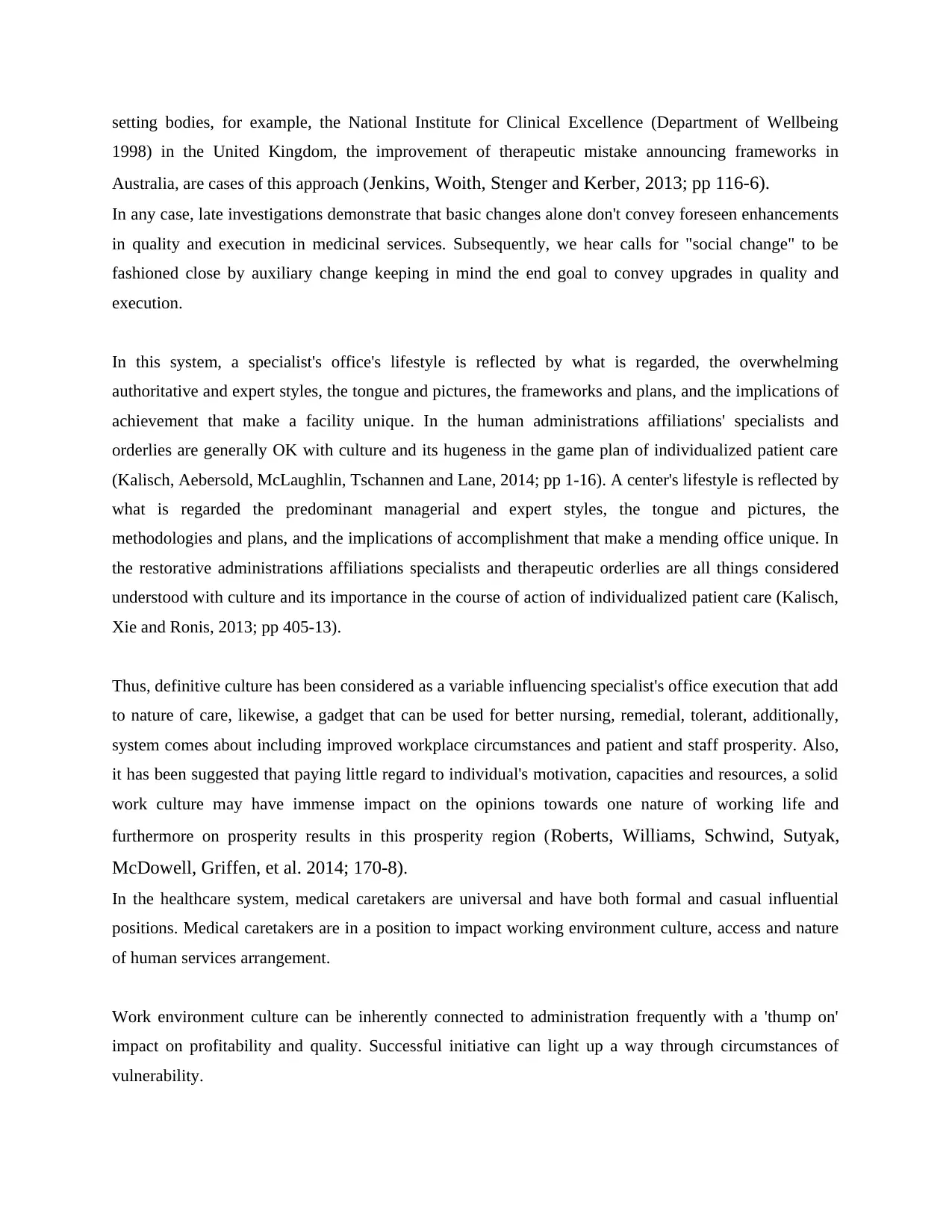
setting bodies, for example, the National Institute for Clinical Excellence (Department of Wellbeing
1998) in the United Kingdom, the improvement of therapeutic mistake announcing frameworks in
Australia, are cases of this approach (Jenkins, Woith, Stenger and Kerber, 2013; pp 116-6).
In any case, late investigations demonstrate that basic changes alone don't convey foreseen enhancements
in quality and execution in medicinal services. Subsequently, we hear calls for "social change" to be
fashioned close by auxiliary change keeping in mind the end goal to convey upgrades in quality and
execution.
In this system, a specialist's office's lifestyle is reflected by what is regarded, the overwhelming
authoritative and expert styles, the tongue and pictures, the frameworks and plans, and the implications of
achievement that make a facility unique. In the human administrations affiliations' specialists and
orderlies are generally OK with culture and its hugeness in the game plan of individualized patient care
(Kalisch, Aebersold, McLaughlin, Tschannen and Lane, 2014; pp 1-16). A center's lifestyle is reflected by
what is regarded the predominant managerial and expert styles, the tongue and pictures, the
methodologies and plans, and the implications of accomplishment that make a mending office unique. In
the restorative administrations affiliations specialists and therapeutic orderlies are all things considered
understood with culture and its importance in the course of action of individualized patient care (Kalisch,
Xie and Ronis, 2013; pp 405-13).
Thus, definitive culture has been considered as a variable influencing specialist's office execution that add
to nature of care, likewise, a gadget that can be used for better nursing, remedial, tolerant, additionally,
system comes about including improved workplace circumstances and patient and staff prosperity. Also,
it has been suggested that paying little regard to individual's motivation, capacities and resources, a solid
work culture may have immense impact on the opinions towards one nature of working life and
furthermore on prosperity results in this prosperity region (Roberts, Williams, Schwind, Sutyak,
McDowell, Griffen, et al. 2014; 170-8).
In the healthcare system, medical caretakers are universal and have both formal and casual influential
positions. Medical caretakers are in a position to impact working environment culture, access and nature
of human services arrangement.
Work environment culture can be inherently connected to administration frequently with a 'thump on'
impact on profitability and quality. Successful initiative can light up a way through circumstances of
vulnerability.
1998) in the United Kingdom, the improvement of therapeutic mistake announcing frameworks in
Australia, are cases of this approach (Jenkins, Woith, Stenger and Kerber, 2013; pp 116-6).
In any case, late investigations demonstrate that basic changes alone don't convey foreseen enhancements
in quality and execution in medicinal services. Subsequently, we hear calls for "social change" to be
fashioned close by auxiliary change keeping in mind the end goal to convey upgrades in quality and
execution.
In this system, a specialist's office's lifestyle is reflected by what is regarded, the overwhelming
authoritative and expert styles, the tongue and pictures, the frameworks and plans, and the implications of
achievement that make a facility unique. In the human administrations affiliations' specialists and
orderlies are generally OK with culture and its hugeness in the game plan of individualized patient care
(Kalisch, Aebersold, McLaughlin, Tschannen and Lane, 2014; pp 1-16). A center's lifestyle is reflected by
what is regarded the predominant managerial and expert styles, the tongue and pictures, the
methodologies and plans, and the implications of accomplishment that make a mending office unique. In
the restorative administrations affiliations specialists and therapeutic orderlies are all things considered
understood with culture and its importance in the course of action of individualized patient care (Kalisch,
Xie and Ronis, 2013; pp 405-13).
Thus, definitive culture has been considered as a variable influencing specialist's office execution that add
to nature of care, likewise, a gadget that can be used for better nursing, remedial, tolerant, additionally,
system comes about including improved workplace circumstances and patient and staff prosperity. Also,
it has been suggested that paying little regard to individual's motivation, capacities and resources, a solid
work culture may have immense impact on the opinions towards one nature of working life and
furthermore on prosperity results in this prosperity region (Roberts, Williams, Schwind, Sutyak,
McDowell, Griffen, et al. 2014; 170-8).
In the healthcare system, medical caretakers are universal and have both formal and casual influential
positions. Medical caretakers are in a position to impact working environment culture, access and nature
of human services arrangement.
Work environment culture can be inherently connected to administration frequently with a 'thump on'
impact on profitability and quality. Successful initiative can light up a way through circumstances of
vulnerability.
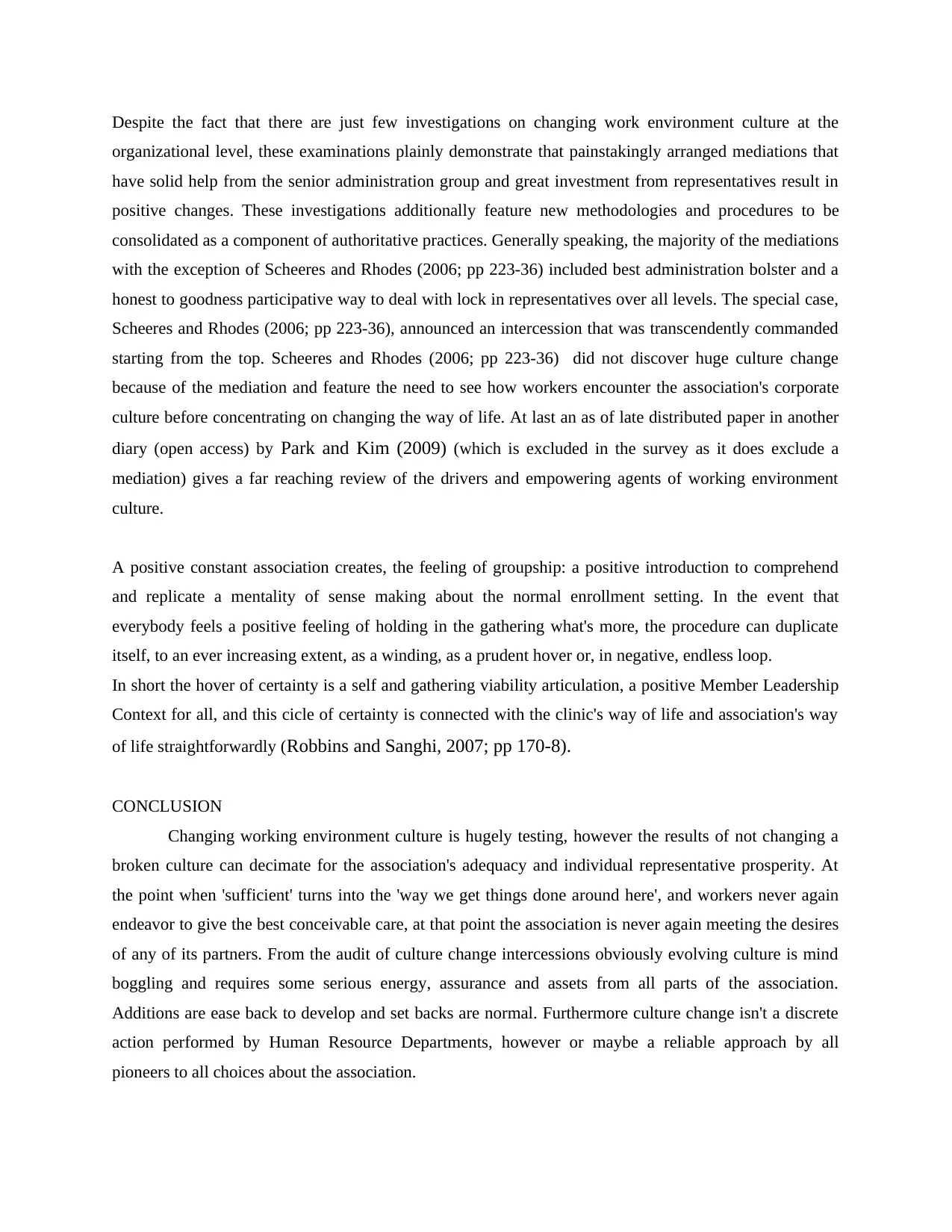
Despite the fact that there are just few investigations on changing work environment culture at the
organizational level, these examinations plainly demonstrate that painstakingly arranged mediations that
have solid help from the senior administration group and great investment from representatives result in
positive changes. These investigations additionally feature new methodologies and procedures to be
consolidated as a component of authoritative practices. Generally speaking, the majority of the mediations
with the exception of Scheeres and Rhodes (2006; pp 223-36) included best administration bolster and a
honest to goodness participative way to deal with lock in representatives over all levels. The special case,
Scheeres and Rhodes (2006; pp 223-36), announced an intercession that was transcendently commanded
starting from the top. Scheeres and Rhodes (2006; pp 223-36) did not discover huge culture change
because of the mediation and feature the need to see how workers encounter the association's corporate
culture before concentrating on changing the way of life. At last an as of late distributed paper in another
diary (open access) by Park and Kim (2009) (which is excluded in the survey as it does exclude a
mediation) gives a far reaching review of the drivers and empowering agents of working environment
culture.
A positive constant association creates, the feeling of groupship: a positive introduction to comprehend
and replicate a mentality of sense making about the normal enrollment setting. In the event that
everybody feels a positive feeling of holding in the gathering what's more, the procedure can duplicate
itself, to an ever increasing extent, as a winding, as a prudent hover or, in negative, endless loop.
In short the hover of certainty is a self and gathering viability articulation, a positive Member Leadership
Context for all, and this cicle of certainty is connected with the clinic's way of life and association's way
of life straightforwardly (Robbins and Sanghi, 2007; pp 170-8).
CONCLUSION
Changing working environment culture is hugely testing, however the results of not changing a
broken culture can decimate for the association's adequacy and individual representative prosperity. At
the point when 'sufficient' turns into the 'way we get things done around here', and workers never again
endeavor to give the best conceivable care, at that point the association is never again meeting the desires
of any of its partners. From the audit of culture change intercessions obviously evolving culture is mind
boggling and requires some serious energy, assurance and assets from all parts of the association.
Additions are ease back to develop and set backs are normal. Furthermore culture change isn't a discrete
action performed by Human Resource Departments, however or maybe a reliable approach by all
pioneers to all choices about the association.
organizational level, these examinations plainly demonstrate that painstakingly arranged mediations that
have solid help from the senior administration group and great investment from representatives result in
positive changes. These investigations additionally feature new methodologies and procedures to be
consolidated as a component of authoritative practices. Generally speaking, the majority of the mediations
with the exception of Scheeres and Rhodes (2006; pp 223-36) included best administration bolster and a
honest to goodness participative way to deal with lock in representatives over all levels. The special case,
Scheeres and Rhodes (2006; pp 223-36), announced an intercession that was transcendently commanded
starting from the top. Scheeres and Rhodes (2006; pp 223-36) did not discover huge culture change
because of the mediation and feature the need to see how workers encounter the association's corporate
culture before concentrating on changing the way of life. At last an as of late distributed paper in another
diary (open access) by Park and Kim (2009) (which is excluded in the survey as it does exclude a
mediation) gives a far reaching review of the drivers and empowering agents of working environment
culture.
A positive constant association creates, the feeling of groupship: a positive introduction to comprehend
and replicate a mentality of sense making about the normal enrollment setting. In the event that
everybody feels a positive feeling of holding in the gathering what's more, the procedure can duplicate
itself, to an ever increasing extent, as a winding, as a prudent hover or, in negative, endless loop.
In short the hover of certainty is a self and gathering viability articulation, a positive Member Leadership
Context for all, and this cicle of certainty is connected with the clinic's way of life and association's way
of life straightforwardly (Robbins and Sanghi, 2007; pp 170-8).
CONCLUSION
Changing working environment culture is hugely testing, however the results of not changing a
broken culture can decimate for the association's adequacy and individual representative prosperity. At
the point when 'sufficient' turns into the 'way we get things done around here', and workers never again
endeavor to give the best conceivable care, at that point the association is never again meeting the desires
of any of its partners. From the audit of culture change intercessions obviously evolving culture is mind
boggling and requires some serious energy, assurance and assets from all parts of the association.
Additions are ease back to develop and set backs are normal. Furthermore culture change isn't a discrete
action performed by Human Resource Departments, however or maybe a reliable approach by all
pioneers to all choices about the association.
Paraphrase This Document
Need a fresh take? Get an instant paraphrase of this document with our AI Paraphraser
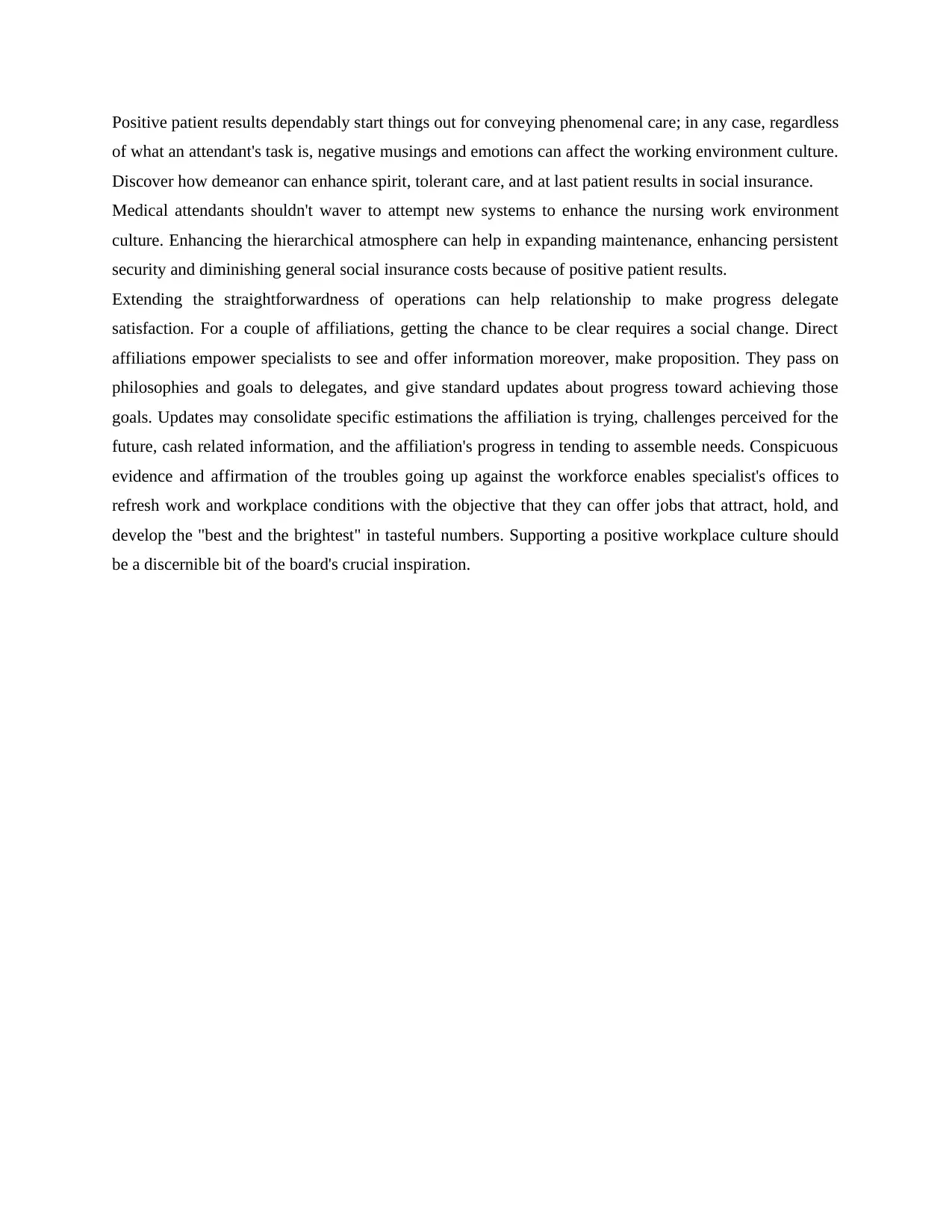
Positive patient results dependably start things out for conveying phenomenal care; in any case, regardless
of what an attendant's task is, negative musings and emotions can affect the working environment culture.
Discover how demeanor can enhance spirit, tolerant care, and at last patient results in social insurance.
Medical attendants shouldn't waver to attempt new systems to enhance the nursing work environment
culture. Enhancing the hierarchical atmosphere can help in expanding maintenance, enhancing persistent
security and diminishing general social insurance costs because of positive patient results.
Extending the straightforwardness of operations can help relationship to make progress delegate
satisfaction. For a couple of affiliations, getting the chance to be clear requires a social change. Direct
affiliations empower specialists to see and offer information moreover, make proposition. They pass on
philosophies and goals to delegates, and give standard updates about progress toward achieving those
goals. Updates may consolidate specific estimations the affiliation is trying, challenges perceived for the
future, cash related information, and the affiliation's progress in tending to assemble needs. Conspicuous
evidence and affirmation of the troubles going up against the workforce enables specialist's offices to
refresh work and workplace conditions with the objective that they can offer jobs that attract, hold, and
develop the "best and the brightest" in tasteful numbers. Supporting a positive workplace culture should
be a discernible bit of the board's crucial inspiration.
of what an attendant's task is, negative musings and emotions can affect the working environment culture.
Discover how demeanor can enhance spirit, tolerant care, and at last patient results in social insurance.
Medical attendants shouldn't waver to attempt new systems to enhance the nursing work environment
culture. Enhancing the hierarchical atmosphere can help in expanding maintenance, enhancing persistent
security and diminishing general social insurance costs because of positive patient results.
Extending the straightforwardness of operations can help relationship to make progress delegate
satisfaction. For a couple of affiliations, getting the chance to be clear requires a social change. Direct
affiliations empower specialists to see and offer information moreover, make proposition. They pass on
philosophies and goals to delegates, and give standard updates about progress toward achieving those
goals. Updates may consolidate specific estimations the affiliation is trying, challenges perceived for the
future, cash related information, and the affiliation's progress in tending to assemble needs. Conspicuous
evidence and affirmation of the troubles going up against the workforce enables specialist's offices to
refresh work and workplace conditions with the objective that they can offer jobs that attract, hold, and
develop the "best and the brightest" in tasteful numbers. Supporting a positive workplace culture should
be a discernible bit of the board's crucial inspiration.
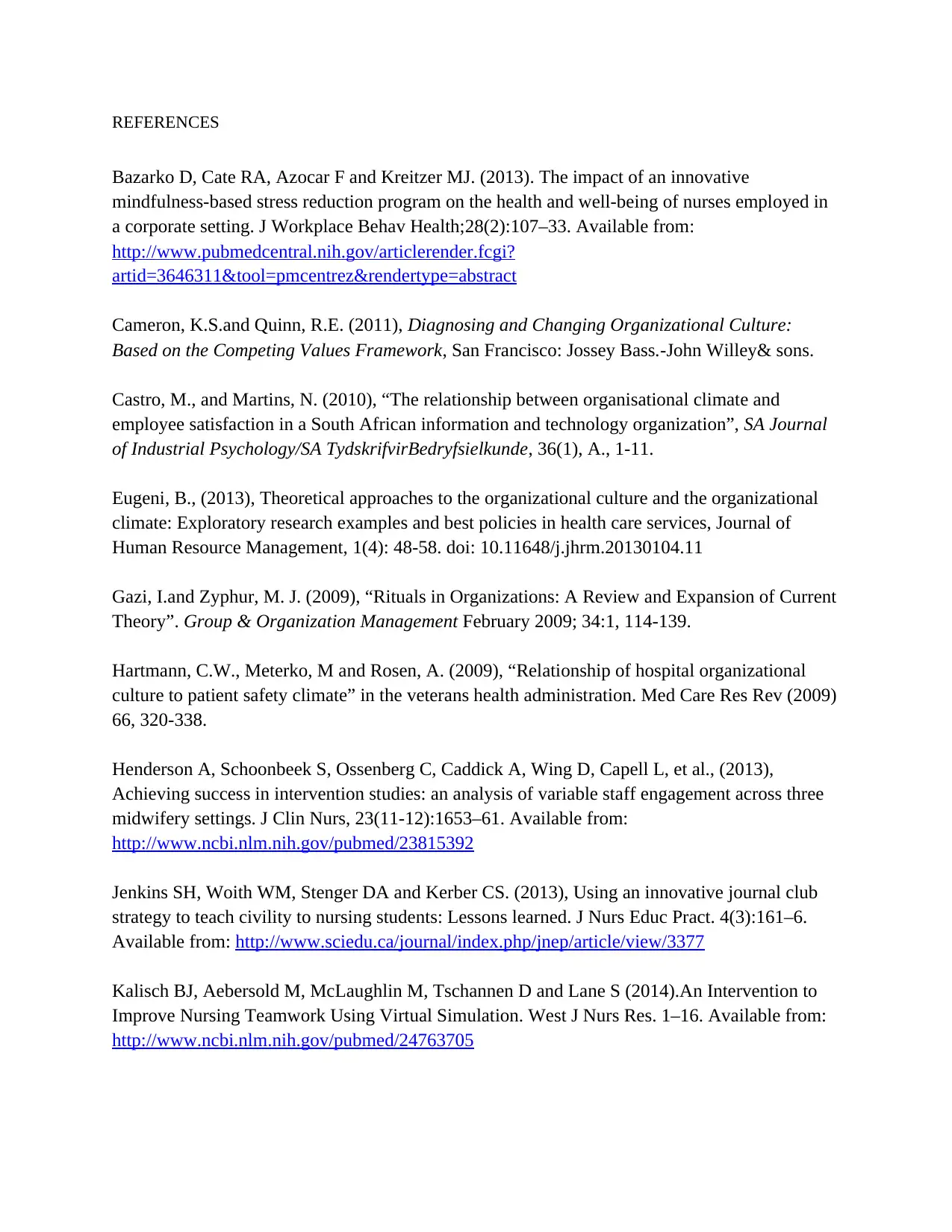
REFERENCES
Bazarko D, Cate RA, Azocar F and Kreitzer MJ. (2013). The impact of an innovative
mindfulness-based stress reduction program on the health and well-being of nurses employed in
a corporate setting. J Workplace Behav Health;28(2):107–33. Available from:
http://www.pubmedcentral.nih.gov/articlerender.fcgi?
artid=3646311&tool=pmcentrez&rendertype=abstract
Cameron, K.S.and Quinn, R.E. (2011), Diagnosing and Changing Organizational Culture:
Based on the Competing Values Framework, San Francisco: Jossey Bass.-John Willey& sons.
Castro, M., and Martins, N. (2010), “The relationship between organisational climate and
employee satisfaction in a South African information and technology organization”, SA Journal
of Industrial Psychology/SA TydskrifvirBedryfsielkunde, 36(1), A., 1-11.
Eugeni, B., (2013), Theoretical approaches to the organizational culture and the organizational
climate: Exploratory research examples and best policies in health care services, Journal of
Human Resource Management, 1(4): 48-58. doi: 10.11648/j.jhrm.20130104.11
Gazi, I.and Zyphur, M. J. (2009), “Rituals in Organizations: A Review and Expansion of Current
Theory”. Group & Organization Management February 2009; 34:1, 114-139.
Hartmann, C.W., Meterko, M and Rosen, A. (2009), “Relationship of hospital organizational
culture to patient safety climate” in the veterans health administration. Med Care Res Rev (2009)
66, 320-338.
Henderson A, Schoonbeek S, Ossenberg C, Caddick A, Wing D, Capell L, et al., (2013),
Achieving success in intervention studies: an analysis of variable staff engagement across three
midwifery settings. J Clin Nurs, 23(11-12):1653–61. Available from:
http://www.ncbi.nlm.nih.gov/pubmed/23815392
Jenkins SH, Woith WM, Stenger DA and Kerber CS. (2013), Using an innovative journal club
strategy to teach civility to nursing students: Lessons learned. J Nurs Educ Pract. 4(3):161–6.
Available from: http://www.sciedu.ca/journal/index.php/jnep/article/view/3377
Kalisch BJ, Aebersold M, McLaughlin M, Tschannen D and Lane S (2014).An Intervention to
Improve Nursing Teamwork Using Virtual Simulation. West J Nurs Res. 1–16. Available from:
http://www.ncbi.nlm.nih.gov/pubmed/24763705
Bazarko D, Cate RA, Azocar F and Kreitzer MJ. (2013). The impact of an innovative
mindfulness-based stress reduction program on the health and well-being of nurses employed in
a corporate setting. J Workplace Behav Health;28(2):107–33. Available from:
http://www.pubmedcentral.nih.gov/articlerender.fcgi?
artid=3646311&tool=pmcentrez&rendertype=abstract
Cameron, K.S.and Quinn, R.E. (2011), Diagnosing and Changing Organizational Culture:
Based on the Competing Values Framework, San Francisco: Jossey Bass.-John Willey& sons.
Castro, M., and Martins, N. (2010), “The relationship between organisational climate and
employee satisfaction in a South African information and technology organization”, SA Journal
of Industrial Psychology/SA TydskrifvirBedryfsielkunde, 36(1), A., 1-11.
Eugeni, B., (2013), Theoretical approaches to the organizational culture and the organizational
climate: Exploratory research examples and best policies in health care services, Journal of
Human Resource Management, 1(4): 48-58. doi: 10.11648/j.jhrm.20130104.11
Gazi, I.and Zyphur, M. J. (2009), “Rituals in Organizations: A Review and Expansion of Current
Theory”. Group & Organization Management February 2009; 34:1, 114-139.
Hartmann, C.W., Meterko, M and Rosen, A. (2009), “Relationship of hospital organizational
culture to patient safety climate” in the veterans health administration. Med Care Res Rev (2009)
66, 320-338.
Henderson A, Schoonbeek S, Ossenberg C, Caddick A, Wing D, Capell L, et al., (2013),
Achieving success in intervention studies: an analysis of variable staff engagement across three
midwifery settings. J Clin Nurs, 23(11-12):1653–61. Available from:
http://www.ncbi.nlm.nih.gov/pubmed/23815392
Jenkins SH, Woith WM, Stenger DA and Kerber CS. (2013), Using an innovative journal club
strategy to teach civility to nursing students: Lessons learned. J Nurs Educ Pract. 4(3):161–6.
Available from: http://www.sciedu.ca/journal/index.php/jnep/article/view/3377
Kalisch BJ, Aebersold M, McLaughlin M, Tschannen D and Lane S (2014).An Intervention to
Improve Nursing Teamwork Using Virtual Simulation. West J Nurs Res. 1–16. Available from:
http://www.ncbi.nlm.nih.gov/pubmed/24763705
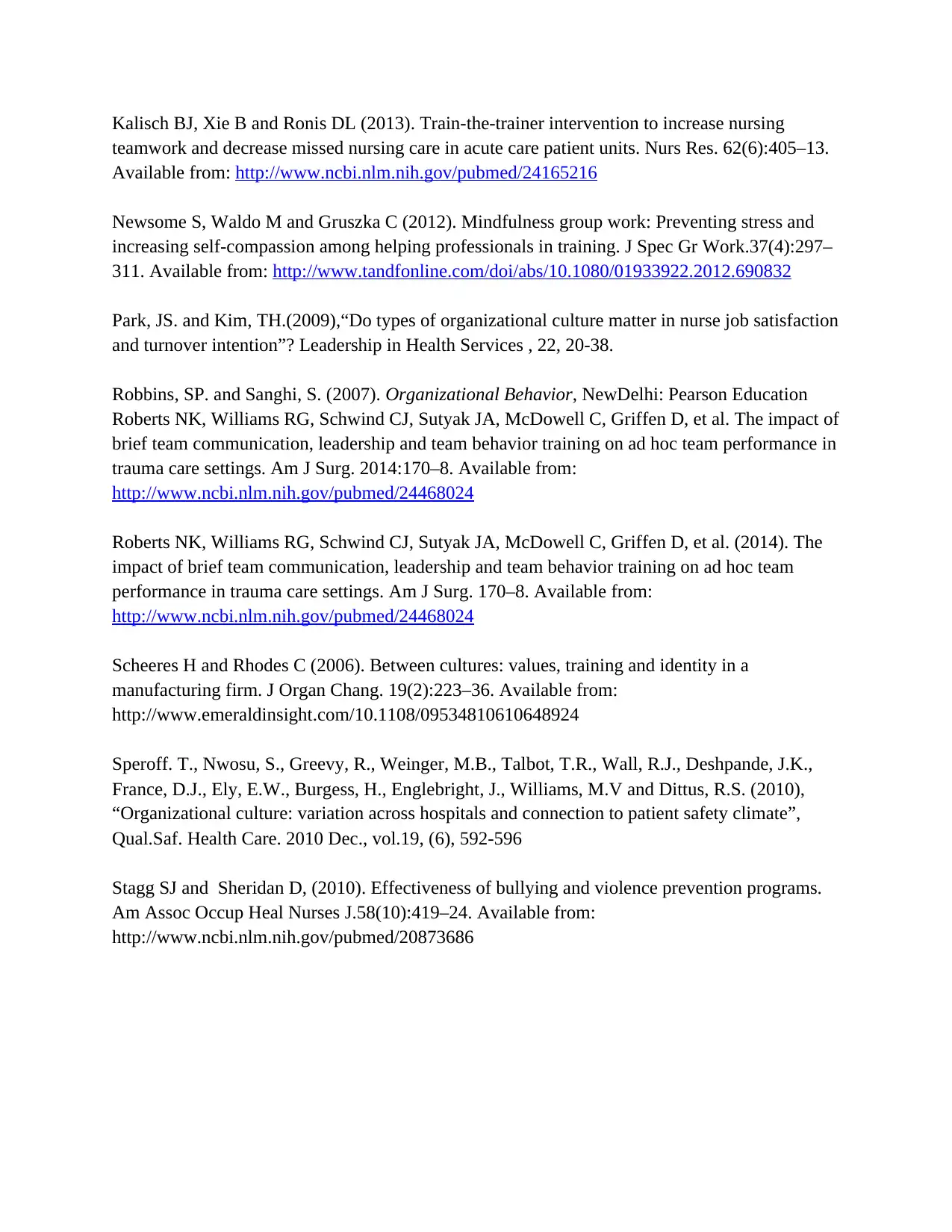
Kalisch BJ, Xie B and Ronis DL (2013). Train-the-trainer intervention to increase nursing
teamwork and decrease missed nursing care in acute care patient units. Nurs Res. 62(6):405–13.
Available from: http://www.ncbi.nlm.nih.gov/pubmed/24165216
Newsome S, Waldo M and Gruszka C (2012). Mindfulness group work: Preventing stress and
increasing self-compassion among helping professionals in training. J Spec Gr Work.37(4):297–
311. Available from: http://www.tandfonline.com/doi/abs/10.1080/01933922.2012.690832
Park, JS. and Kim, TH.(2009),“Do types of organizational culture matter in nurse job satisfaction
and turnover intention”? Leadership in Health Services , 22, 20-38.
Robbins, SP. and Sanghi, S. (2007). Organizational Behavior, NewDelhi: Pearson Education
Roberts NK, Williams RG, Schwind CJ, Sutyak JA, McDowell C, Griffen D, et al. The impact of
brief team communication, leadership and team behavior training on ad hoc team performance in
trauma care settings. Am J Surg. 2014:170–8. Available from:
http://www.ncbi.nlm.nih.gov/pubmed/24468024
Roberts NK, Williams RG, Schwind CJ, Sutyak JA, McDowell C, Griffen D, et al. (2014). The
impact of brief team communication, leadership and team behavior training on ad hoc team
performance in trauma care settings. Am J Surg. 170–8. Available from:
http://www.ncbi.nlm.nih.gov/pubmed/24468024
Scheeres H and Rhodes C (2006). Between cultures: values, training and identity in a
manufacturing firm. J Organ Chang. 19(2):223–36. Available from:
http://www.emeraldinsight.com/10.1108/09534810610648924
Speroff. T., Nwosu, S., Greevy, R., Weinger, M.B., Talbot, T.R., Wall, R.J., Deshpande, J.K.,
France, D.J., Ely, E.W., Burgess, H., Englebright, J., Williams, M.V and Dittus, R.S. (2010),
“Organizational culture: variation across hospitals and connection to patient safety climate”,
Qual.Saf. Health Care. 2010 Dec., vol.19, (6), 592-596
Stagg SJ and Sheridan D, (2010). Effectiveness of bullying and violence prevention programs.
Am Assoc Occup Heal Nurses J.58(10):419–24. Available from:
http://www.ncbi.nlm.nih.gov/pubmed/20873686
teamwork and decrease missed nursing care in acute care patient units. Nurs Res. 62(6):405–13.
Available from: http://www.ncbi.nlm.nih.gov/pubmed/24165216
Newsome S, Waldo M and Gruszka C (2012). Mindfulness group work: Preventing stress and
increasing self-compassion among helping professionals in training. J Spec Gr Work.37(4):297–
311. Available from: http://www.tandfonline.com/doi/abs/10.1080/01933922.2012.690832
Park, JS. and Kim, TH.(2009),“Do types of organizational culture matter in nurse job satisfaction
and turnover intention”? Leadership in Health Services , 22, 20-38.
Robbins, SP. and Sanghi, S. (2007). Organizational Behavior, NewDelhi: Pearson Education
Roberts NK, Williams RG, Schwind CJ, Sutyak JA, McDowell C, Griffen D, et al. The impact of
brief team communication, leadership and team behavior training on ad hoc team performance in
trauma care settings. Am J Surg. 2014:170–8. Available from:
http://www.ncbi.nlm.nih.gov/pubmed/24468024
Roberts NK, Williams RG, Schwind CJ, Sutyak JA, McDowell C, Griffen D, et al. (2014). The
impact of brief team communication, leadership and team behavior training on ad hoc team
performance in trauma care settings. Am J Surg. 170–8. Available from:
http://www.ncbi.nlm.nih.gov/pubmed/24468024
Scheeres H and Rhodes C (2006). Between cultures: values, training and identity in a
manufacturing firm. J Organ Chang. 19(2):223–36. Available from:
http://www.emeraldinsight.com/10.1108/09534810610648924
Speroff. T., Nwosu, S., Greevy, R., Weinger, M.B., Talbot, T.R., Wall, R.J., Deshpande, J.K.,
France, D.J., Ely, E.W., Burgess, H., Englebright, J., Williams, M.V and Dittus, R.S. (2010),
“Organizational culture: variation across hospitals and connection to patient safety climate”,
Qual.Saf. Health Care. 2010 Dec., vol.19, (6), 592-596
Stagg SJ and Sheridan D, (2010). Effectiveness of bullying and violence prevention programs.
Am Assoc Occup Heal Nurses J.58(10):419–24. Available from:
http://www.ncbi.nlm.nih.gov/pubmed/20873686
1 out of 10
Your All-in-One AI-Powered Toolkit for Academic Success.
+13062052269
info@desklib.com
Available 24*7 on WhatsApp / Email
![[object Object]](/_next/static/media/star-bottom.7253800d.svg)
Unlock your academic potential
© 2024 | Zucol Services PVT LTD | All rights reserved.